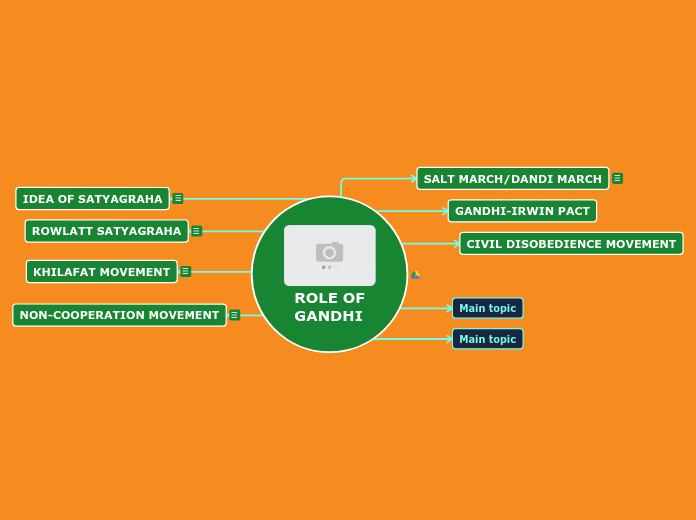
ROLE OF
GANDHI
SALT MARCH/DANDI MARCH
Mahatma Gandhi found in salt a powerful symbol that could unite the nation. On 31 January 1930, he sent a letter to Viceroy Irwin stating eleven demandsThe most stirring of all was the demand to abolish the salt tax. Salt was something consumed by the rich and the poor alike.Mahatma Gandhi started the salt march accompanied by 78 of his trusted volunteers who walked over 240 miles for 24 days, from Sabarmati to Dandi.On 6 April he reached Dandi, and ceremonially violated the law, manufacturing salt by boiling sea water. This marked the beginning of the Civil Disobedience Movement.A frightened government responded with a policy of brutal repression. Peaceful satyagrahis were attacked, women and children were beaten, and about 100,000 people were arrested.In such a situation, Mahatma Gandhi once again decided to call off the movement and entered into a pact with Irwin on 5 March 1931.
GANDHI-IRWIN PACT
CIVIL DISOBEDIENCE MOVEMENT
Main topic
Main topic
IDEA OF SATYAGRAHA
Mahatma Gandhi returned to India in January 1915 from South Africa where he had successfully fought the racist regime with a novel method of mass agitation, which he called satyagraha.The idea of satyagraha emphasized the power of truth and the need to search for truth. Mahatma Gandhi believed that this dharma of non-violence could unite all Indians.After arriving in India, Mahatma Gandhi successfully organized satyagraha movements in various places like:- In 1916 he travelled to Champaran in Bihar to inspire the peasants to struggle against the oppressive plantation system.In 1917, he organized a satyagraha to support the peasants of the Kheda district of Gujarat. Affected by crop failure and a plague epidemic, the peasants of Kheda could not pay the revenue, and were demanding that revenue collection be relaxed.In 1918, Mahatma Gandhi went to Ahmedabad to organize a satyagraha movement amongst cotton mill workers.
ROWLATT SATYAGRAHA
Emboldened with this success, Gandhiji in 1919 decided to launch a nationwide satyagraha against the proposed Rowlatt Act of 1919.This act gave the government enormous powers to repress political activities. Mahatma Gandhi wanted non-violent civil disobedience against such unjust laws.Rallies were organized in various cities, workers went on strike in railway workshops, and shops closed down.Alarmed by the popular upsurge, the British administration decided to clamp down on nationalists.Local leaders were picked up from Amritsar, and Mahatma Gandhi was barred from entering Delhi.Martial law was imposed and General Dyer took command.On 13 April the infamous Jallianwalla Bagh incident took place.Dyer entered the area, blocked the exit points, and opened fire on the crowd, killing hundreds.As the news of Jallianwalla Bagh spread, crowds took to the streets in many north Indian towns. There were strikes, clashes with the police and attacks on government buildings.The government responded with brutal repression, seeking to humiliate and terrorise people.Seeing violence spread, Mahatma Gandhi called off the movement.
KHILAFAT MOVEMENT
While the Rowlatt satyagraha had been a widespread movement, it was still limited mostly to cities and towns.Mahatma Gandhi now felt the need to launch a more broad-based movement in India.But he was certain that no such movement could be organized without bringing the Hindus and Muslims closer together.A young generation of Muslim leaders like the brothers Muhammad Ali and Shaukat Ali, began discussing with Mahatma Gandhi about the possibility of a united mass action on the issue.Gandhiji saw this as an opportunity to bring Muslims under the umbrella of a unified national movement.Under the guidance of Mahatma Gandhi the movement was launched against the British government to restore the collapsing status of the Caliph in Turkey. At the Calcutta session of the Congress in September 1920, he convinced other leaders of the need to start a non-cooperation movement in support of Khilafat as well as for swaraj.
NON-COOPERATION MOVEMENT
In his famous book Hind Swaraj (1909) Mahatma Gandhi declared that British rule was established in India with the cooperation of Indians.He thought that if Indians refused to cooperate, British rule in India would collapse within a year, and swaraj would come.Non-Cooperation movements begins a boycott of civil services, army, police, courts and legislative councils, schools, and foreign goods.Then, in case the government used repression, a full civil disobedience campaign would be launched.Finally, at the Congress session at Nagpur in December 1920, a compromise was worked out and the Non-Cooperation program was adopted
